In the summer of 1965, my father, the painter John H. Kinnear, read an article in the Star Weekly about “The Little Old Lady Who Paints Pretty Pictures.” It told of an unknown, self-taught painter in Nova Scotia named Maud Lewis, who was “small and somewhat crippled by arthritis,” and poor. “Maud and her husband Everett, both in their mid-sixties, live in a house so small that it might have been built for Tom Thumb,” wrote Murray Barnard. “The couple have no electricity or running water and none of the other comforts of life.” Images throughout the piece depicted Lewis’s colourful paintings, of cats and horse-drawn carriages, and photographs showed Lewis at work, and standing in front of her tiny, painted home in Marshalltown.
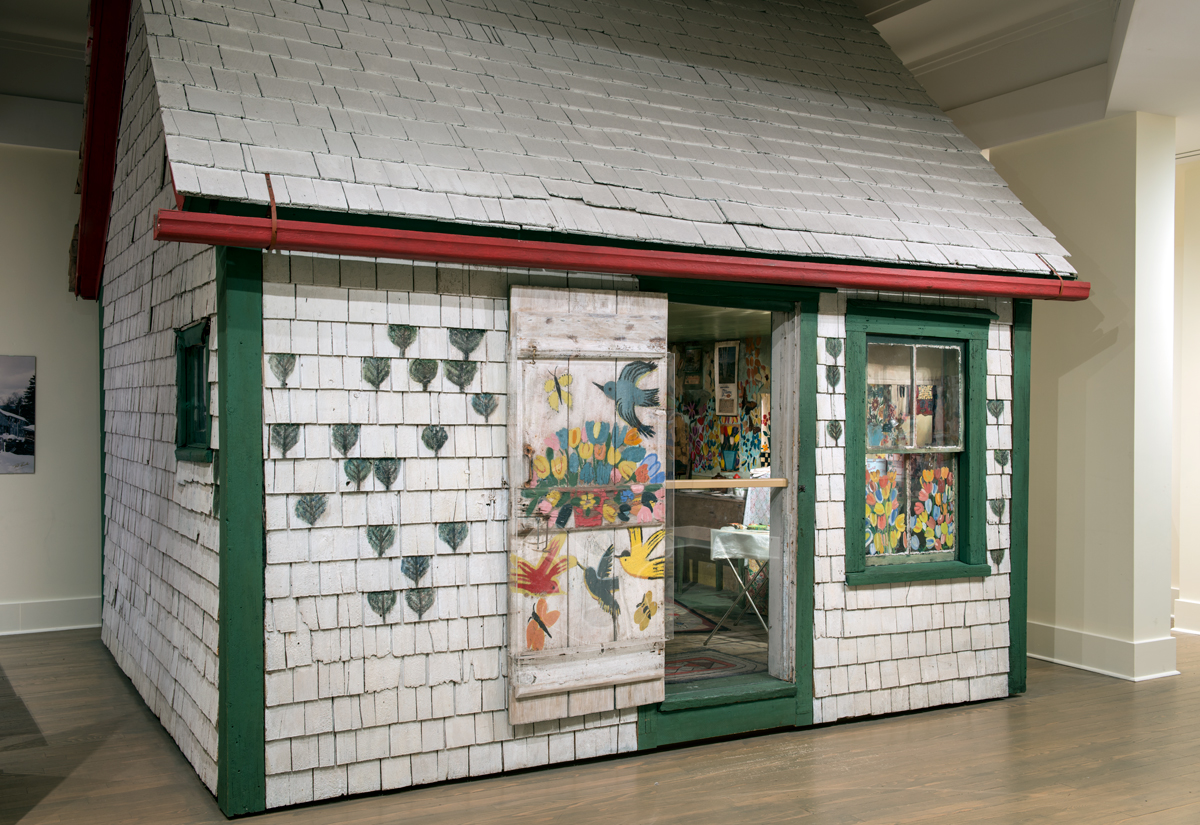 Maud Lewis’s house. Mixed Media. Collection of the Art Gallery of Nova Scotia. Photo: Steve Farmer.
Maud Lewis’s house. Mixed Media. Collection of the Art Gallery of Nova Scotia. Photo: Steve Farmer.
Maud Lewis’s debilitating and life of penury struck my father. As a former prisoner of war in World War II, he knew too well of pain and hardship, and he decided to help her. In the autumn of 1965, he mailed her a box of archival paints, sable brushes and standard Masonite boards, which I had primed. It was the beginning of a friendship that lasted until Lewis’s death in 1970.
My father recognized that Lewis’s paintings deserved archival-quality materials, and that, as an unschooled painter, she was working on found objects or wallboard, with house paint that would eventually peel from its base and disintegrate. He wanted her to have something that would stand the test of time.
During the 1960s there were less than a handful of art supply stores in London, Ontario, where we lived. My father would give me a wink and ask, “Shall we give our legs a good sprint?” I knew that meant it was time to start the eight-block walk over to Anderson’s Art Store to replenish his supplies and pick up extra paints for Lewis.
My father kept a list of paint colours requested by Lewis—she would ask for tubes of acrylic paint in bright red, daffodil yellow, black, sap green, white, brown and different shades of blue, and we would also take home some of the heavy jars of gesso that were needed for priming.
Getting supplies for Lewis was not out of the ordinary for me—as a young girl, I often worked in my father’s Richmond Street studio. It was there, surrounded by art and artists, that I felt most comfortable and at home. Even now, I still love the smell of Dammar varnish with its hint of clove and orange peel. Fine art hung on the walls of the studio: a Greg Curnoe abstract painting, watercolours by William Roberts and more. When I was 12 years old, my father taught me the process of properly sanding and crosshatch priming with gesso on Masonite boards. I used these lessons to prime Lewis’s boards with many coats of gesso to hold a permanent ground.
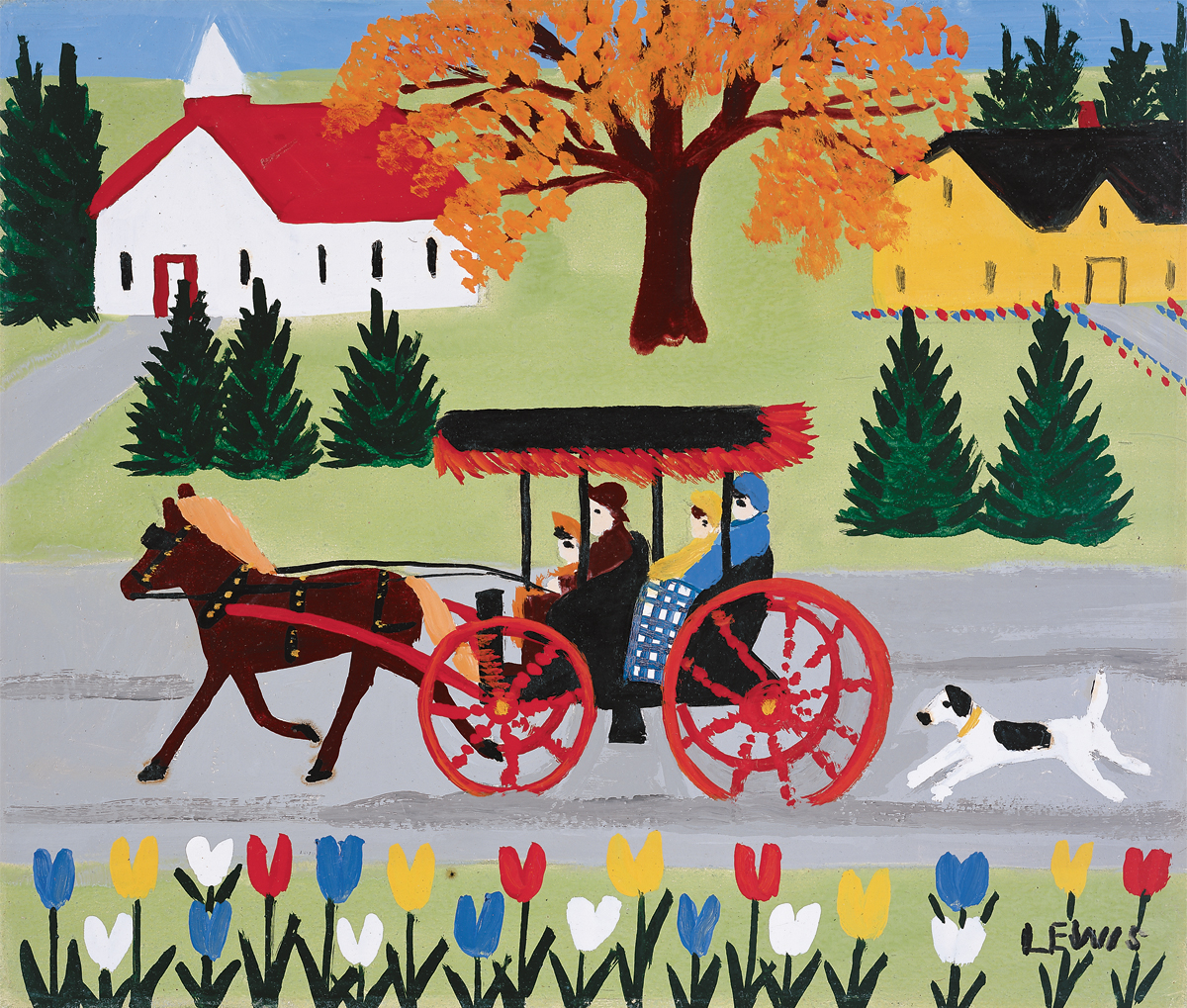 Maud Lewis, Carriage and Dog, n.d. Oil on pulpboard. Private Collection. © Art Gallery of Nova Scotia.
Maud Lewis, Carriage and Dog, n.d. Oil on pulpboard. Private Collection. © Art Gallery of Nova Scotia.
My father and Lewis maintained a long correspondence that began around the fall of 1965. The earliest dated letters from Lewis to my father are from February 1966, but others have no dates or visible postmarks on the envelopes. They talked about many things, but my father never attempted to influence her work. In one letter, he asked whether Lewis would put any of her paintings in the iconic Expo 67 exhibition, which marked Canada’s Centennial. “No I’m not putting anything into Expo 67 I haven’t the time to paint anything for it,” she replied. Lewis complained to my father that she had received over 300 letters after she was profiled for a televised CBC Telescope Program broadcast on November 25, 1965.
“Maud was not a careerist, and she valued those friends, like Ontario painter John Kinnear who corresponded with her regularly, far more than an order from a premier or president,” writes historian Lance Woolaver in The Illuminated Life Of Maud Lewis. Lewis thanked my father for his original gift, and he followed this note of thanks with a second package of supplies, reaffirming the permanence of the archival paints and gessoed boards. After this second package, Lewis insisted on reimbursing my father with her paintings. She asked my father to continue to send her the gessoed boards and paints that she couldn’t find in Nova Scotia.
I remember walking to the post office to pick up the flat, brown-paper packages that Lewis mailed to us. She would send two or three—or occasionally five—paintings, and my father would post packages of five sanded and gessoed Masonite boards. He sold about 40 of Lewis’s paintings in the London and surrounding area for $24 each, sending Lewis some of the profits and using the rest to purchase her paints. He kept several paintings for his own private collection, and gifted two of them to me.
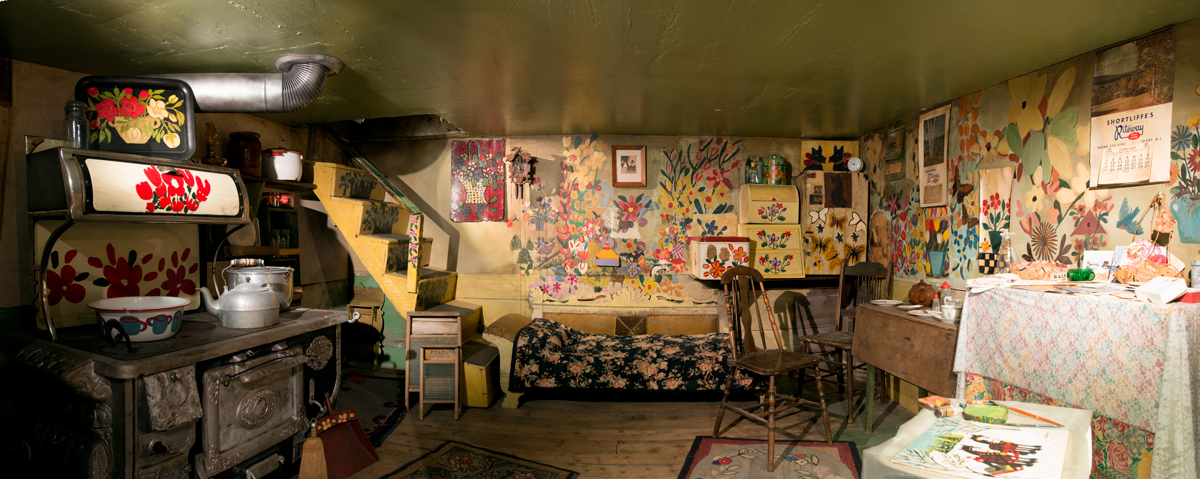 Inside Maud Lewis‘s house. Mixed Media. Collection of the Art Gallery of Nova Scotia. Photo: Steve Farmer.
Inside Maud Lewis‘s house. Mixed Media. Collection of the Art Gallery of Nova Scotia. Photo: Steve Farmer.
Sadly, the Lewis paintings I was gifted were stolen, but I like to think that the boards I sanded and primed with gesso, and the archival paints my father mailed to Lewis, will help preserve her art for future generations—although working alongside my father was reward in itself.
The letters that Maud wrote to my father were kept safely in an antique sea trunk that had once been in his studio. A few months before his death in 2003, my father and I opened his sea trunk together. I remember his smile as we recalled the days gone by, and the little old lady who painted pretty pictures.
Sheila M. Kinnear is a writer and an artist, who studied art theory and criticism at the University of Western Ontario, and the past proprietor of Kinnear Gallery and Framing in London, Ontario.
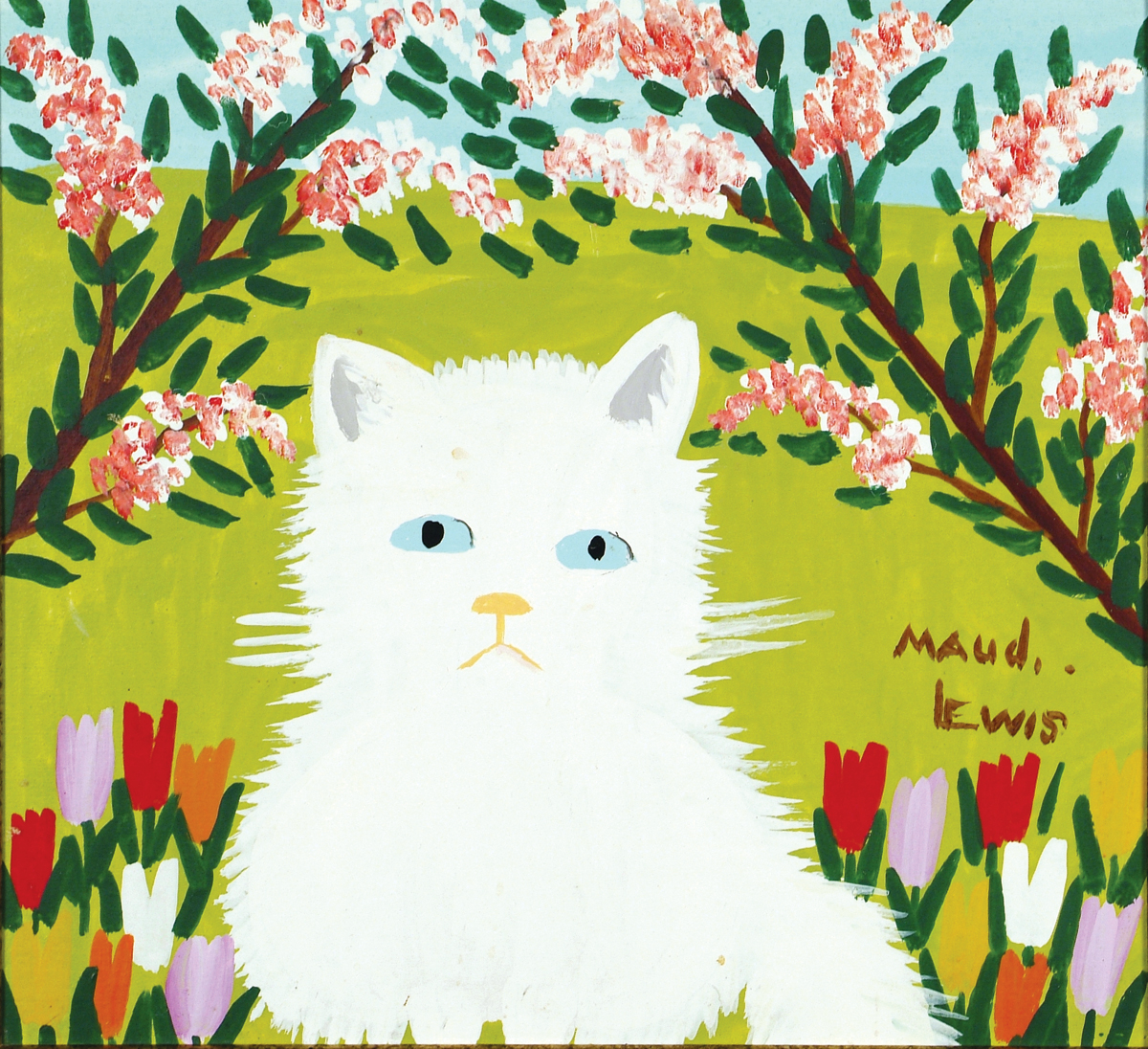 Maud Lewis, White Cat (2), 1960s. Gift of Johanna Hickey, Vancouver, BC, 2006. © Art Gallery of Nova Scotia.
Maud Lewis, White Cat (2), 1960s. Gift of Johanna Hickey, Vancouver, BC, 2006. © Art Gallery of Nova Scotia.

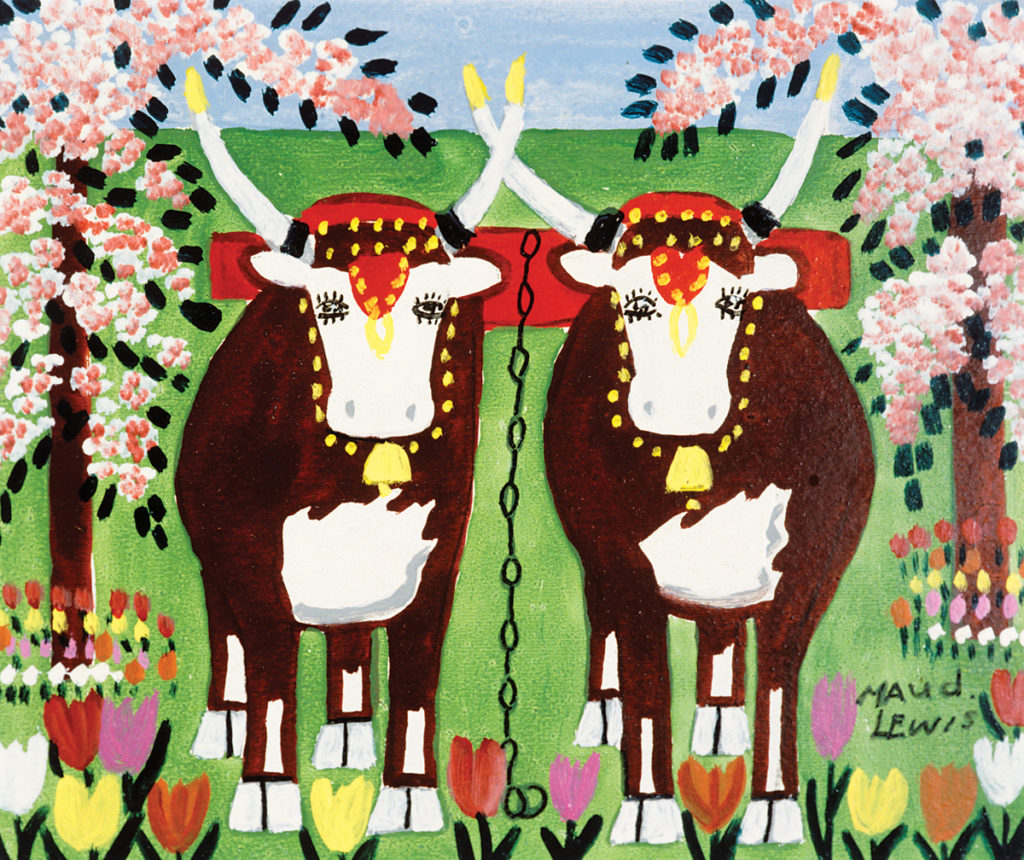 Maud Lewis, Oxen in Spring, c. 1960s. Oil on pulpboard. Private Collection. © Art Gallery of Nova Scotia.
Maud Lewis, Oxen in Spring, c. 1960s. Oil on pulpboard. Private Collection. © Art Gallery of Nova Scotia.







